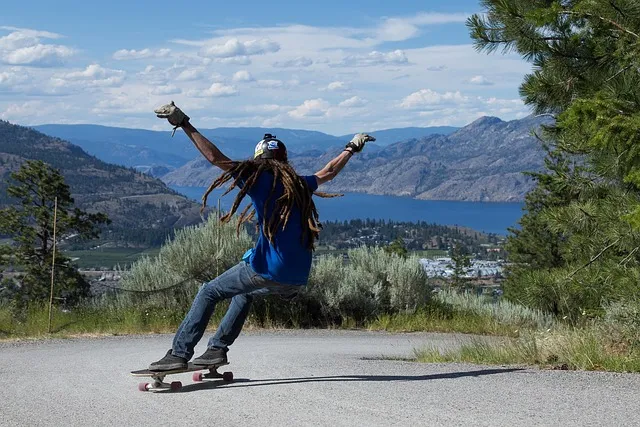Downhill longboarding is an adrenaline-pumping activity that combines skill and precision for a thrilling experience. For beginners looking to enter this sport, it's essential to choose a longboard designed specifically for stability and ease of use. This includes a robust build, premium bearings, oversized wheels suited for high speeds, and a deck length that provides balance without overwhelming new riders. A lower truck angle is recommended initially for enhanced stability. Safety gear, such as a helmet, full padding, and closed-toe shoes with excellent grip, is indispensable for protection. Beginners should start on gentle hills with gradual slopes to practice footbraking, athletic stance, and proper body positioning before tackling steeper terrain. Regular maintenance of the longboard for beginners is crucial to ensure safety during rides. As skills progress, more challenging locations can be explored, but always prioritize safety and weather conditions for an enjoyable and secure downhill longboarding experience.
Embark on the exhilarating journey of downhill longboarding with our comprehensive guide tailored for beginners. Discover the fundamentals, from understanding the sport’s dynamics to mastering essential techniques for a safe and thrilling experience. Learn about the top-rated longboards that cater to novices, complete with key features to navigate the slopes confidently. Safety is paramount, so we’ll outline the indispensable gear you need before your first descent. Whether you’re carving through gentle hills or aiming for steeper slopes, this article will equip you with the knowledge to make informed choices and savor every moment of the ride.
Understanding the Basics of Downhill Longboarding

Downhill longboarding is a thrilling discipline within the sport of longboarding that demands both skill and precision. For those new to the activity, choosing the right longboard for beginners is crucial for a safe and enjoyable experience. A downhill longboard typically features a sturdy construction, high-quality bearings, and large wheels designed to handle high speeds and sharp turns at greater angles without losing stability. The deck should be long enough to provide the necessary leverage but not so long that it becomes unwieldy for beginners. It’s also important to consider the truck setup, as a lower angle provides more stability, which is ideal for those just starting out in downhill longboarding. Proper protective gear, including a helmet, knee pads, elbow pads, and wrist guards, is essential to safeguard against potential falls and impacts on varied terrain.
To begin mastering downhill longboarding, it’s advisable to practice on slight declines before progressing to steeper hills. This allows beginners to familiarize themselves with the board’s responsiveness and handling characteristics under controlled conditions. Techniques such as weight shifting, footbraking, and leveraging the centrifugal force while cornering are fundamental skills that need to be practiced regularly. Additionally, understanding how to read the road ahead, including recognizing obstacles and choosing optimal lines down the hill, is a critical aspect of the learning process. As you progress, focusing on improving your form and technique will enhance your control and confidence on the board. Remember, patience and consistent practice are key to developing proficiency in downhill longboarding.
Top Longboards for Beginners: A Comprehensive Guide

When venturing into the world of downhill riding, selecting a suitable longboard for beginners is paramount to ensure both safety and an enjoyable experience. A longboard designed for novices should offer stability and durability while also providing room for growth as skills improve. The deck must be wide enough for comfortable foot placement, which is often around 40 to 44 inches, offering a greater surface area for balance. For beginners, a slightly softer wheel durometer, typically ranging from 75a to 80a, interacts better with the road’s texture, absorbing minor imperfections and offering a smoother ride. Additionally, reverse kingpin (RKP) trucks are often recommended for newcomers due to their responsiveness and ease of turning, which helps in navigating corners with more precision.
Another critical aspect to consider is the wheel size and hardness, which impact both speed control and overall performance. Smaller wheels, usually around 65mm to 70mm, are ideal for beginners as they offer better grip and stability at lower speeds. However, as confidence grows, longboards with larger wheels can be integrated into the rider’s arsenal for higher speeds and a more cushioned ride over bumps and rough terrain. Bearings also play a significant role in the quality of the ride; high-quality ABEC-7 or ABEC-9 bearings ensure smoother, faster, and longer-lasting performance compared to lower-grade alternatives. Lastly, consider the deck’s material; a reliable longboard for beginners will often feature a bamboo or maple construction, which provides both flexibility and strength, essential for absorbing impacts without compromising on stability. With these factors in mind, any beginner can find an ideal longboard that suits their specific needs and riding style, paving the way for an exhilarating downhill experience.
Key Features to Look for in a Starter Longboard for Downhill Riding

When selecting a longboard tailored for downhill riding as a beginner, it’s crucial to consider several key features that will enhance both your safety and performance on the mountainous terrain. The deck should be sturdy yet flexible, offering a balance between stability and maneuverability. A longer wheelbase is ideal for high-speed stability, ensuring that the board remains predictable and stable at faster speeds, which are common in downhill riding. Look for a deck with a width of around 9 to 10 inches; this size provides ample foot space for beginners to develop their stance and balance without compromising on the board’s responsiveness.
Next, the truck setup plays a vital role in handling and turning sensitivity. High-quality, durable trucks that come with a lower hanger will offer better control at high speeds. A stiffer bushings set typically performs best for downhill due to their ability to maintain stability during fast descents. The wheels are another critical component; choose a hardness rating of 78a or 80a for a balance between grip and slide, which is essential when navigating different surfaces and turns. Additionally, larger wheels (around 70mm) with a proven urethane formula will handle bumps and irregularities in the road surface more effectively. Lastly, ensure that your longboard comes with reliable and responsive bearings; ABEC-5 or higher rated bearings are generally suitable for downhill riding, providing the smooth, high-speed performance that beginners need to enjoy their downhill experience while learning.
Essential Safety Gear for Newcomers to Downhill Longboarding

When venturing into downhill longboarding, safety should be your top priority. As a newcomer to this exhilarating sport, it’s crucial to equip yourself with the right protective gear to minimize the risk of injury. A high-quality helmet, designed specifically for extreme sports, is an absolute must. It should snugly fit your head and offer full protection without obstructing your vision or hearing. Additionally, knee and elbow pads are essential as they provide cushioning upon impact and allow you to maneuver freely, which is vital for maintaining balance and control on steep descents. Wrist guards can also prevent sprains and breaks that commonly occur during falls.
Furthermore, consider investing in a pair of longboard-specific gloves to protect your hands from abrasion and impact. Opt for pads with adjustable straps to ensure a secure fit, and choose materials that offer maximum airflow to keep you cool during longer rides. It’s also wise to wear closed-toe shoes with good grip and ankle support, as they are the interface between you and your longboard. Lastly, reflective gear can enhance visibility to other road users, especially when practicing during low-light conditions. For beginners, starting with a longboard designed for stability and ease of use will contribute significantly to a safer riding experience. Always remember to perform maintenance checks on your longboard before each ride to ensure everything is in optimal condition. With the right gear and mindset, you can embark on your downhill longboarding journey confidently and safely.
Mastering Techniques: Tips for Safe and Enjoyable Downhill Rides

When embarking on a downhill ride using a longboard designed for beginners, mastering the necessary techniques is paramount for both safety and enjoyment. To initiate a safe descent, riders should begin by selecting an appropriate hill with a gentle slope to familiarize themselves with the board’s handling at speed. Practicing footbraking on flat ground will help control speed during the ride, while maintaining an athletic stance allows for better balance and maneuverability. Riders new to downhill longboarding should focus on building confidence by gradually tackling steeper slopes under controlled conditions.
Another crucial aspect is understanding the body’s position relative to the board; leaning forward into the turn initiates the carve, with weight distributed evenly between the front and back wheels. To navigate corners safely, riders should aim to start the lean before reaching the apex of the turn, allowing the longboard to follow the natural contour of the hill. Additionally, practicing pumping—a technique that uses the rider’s body momentum to gain speed—can enhance the downhill experience, providing an alternative to constant footbraking. By incorporating these tips into their practice, beginners can transform their downhill rides into thrilling experiences while minimizing risks and developing their skills on a longboard tailored for the challenge.
Choosing the Right Location and Conditions for Beginner Downhill Longboarding

When embarking on downhill longboarding for the first time, selecting the right location and conditions is paramount to ensure safety and enjoyment. A beginner should look for a long, gradual hill with a consistent slope that’s free of obstacles like rocks, debris, or sharp turns. The ideal location will have a smooth pavement surface to minimize the risk of wheel bite or loss of control due to uneven terrain. It’s also crucial to choose a hill that isn’t too steep; a 3% to 8% gradient is often recommended for beginners, as it allows them to practice and gain confidence at a manageable speed.
In addition to the location, considering the weather conditions is essential. Ideally, the air temperature should be comfortable to prevent fatigue, and there shouldn’t be any rain or moisture on the road that could create slippery conditions. The best times for beginner downhill longboarding are typically in the late morning after the dew has evaporated but before the afternoon heat can affect performance. Beginners should also start with shorter runs to acclimate to the sensation of speed and the dynamics of steering and braking on a longboard. As skill levels improve, more challenging hills and varying conditions can be explored, but always prioritize safety and awareness of one’s surroundings. A longboard designed for beginners, with features like reliable trucks, grippy deck tape, and responsive wheels, will enhance the learning experience and provide a solid foundation for progression in this exhilarating sport.
